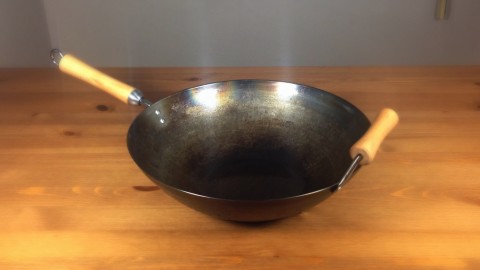
To most people, a wok is a kitchen unitasker.
You’ll drag it out one every year (or five) for a Chinese meal, before putting back in the cabinet, right next to the ice cream maker and Sodastream… right?
Nope.
The wok is one of the most underrated pieces of kitchen cookware, and is one that I’d suggest most “intermediate” kitchen hackers add into their repertoire.
Yes, woks are essential for stir-frying, but they can do so much more.
Here’s a few of the many reasons I think a wok is a great kitchen tool, and a guide for how to buy (and care for) a new wok.
Stir-Frying (and Beyond)–The Ultimate Wok Technique
Let’s get the most obvious one out of the way first.
Woks are used across Eastern- and Southeast Asia as a primary kitchen tool, where they are generally heated to scorching temperatures before quickly cooking up small pieces of meat and veggies in delicious sauces.
Traditionally, woks were completely round on the bottom, and fit in Asian stovetops (which usually didn’t have the flat surface that we Westerners are used to).
What this effectively did was create a small area of extremely high heat on the bottom of the wok, with the temperature dramatically decreasing as you go up the sides.
The constant stirring is necessary to both keep the food on the bottom from burning, but to also ensure the stuff on the sides gets cooked all the way through.
Now for the unfortunate part…
There’s a common belief that woks are completely useless in Western kitchens, and that we should just do our stir-frying in large pans.
I disagree with this for a few reasons.
First, there’s an issue with capacity. A big skillet just isn’t going to have the space that a wok will, and you have to either stir-fry several small batches or end up flipping half your food out of the pan.
Pain in the ass.
Second, there’s a lot of other uses that woks excel at, and can fill in for both your Dutch oven and your skillet if they’re in use.
So woks aren’t only necessary for good stir-frying, but they can take the place of your Dutch oven, skillet, and even saucepan if they are in use.
The key to proper stir-frying is to use high heat.
If you can use the burner on your stove, that’s great. But another way to turbocharge this process is to cook over a chimney starter full of white-hot coals. You may need to cut a few holes in the starter to ensure good airflow, but it fits perfectly (and keeps the house from getting smokey).
But don’t think that you can only fry over high heat with a wok. You can easily use less heat and fry up greens and other veggies as well.
Think of it as a backup skillet if your main tool is in use.
Steaming–Forget About the “Health Benefits,” It’s Just Faster
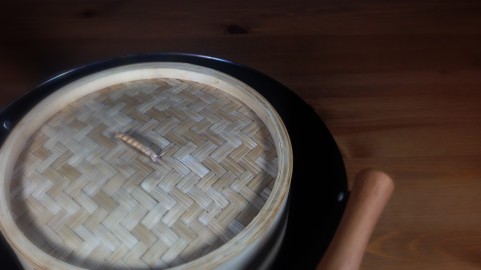
I’ve slowly given up on steaming.
I think the purported health benefits are blown out of proportion, and you need to add a bunch of butter or olive oil to steamed foods anyways to make them palatable.
That said, steaming will do practically the same job as boiling, but since there’s less water you need to heat up, you can theoretically do it faster.
Plus you get to use bamboo steamers with your wok! Awesome!
Yeah, I know they’re big and bulky, but they hold a lot more than those small collapsible steamers. You can even stack them on top of one another to get a whole lotta steamin’ done.
One thing I like about steaming is that it’s ideal for reheating foods you’re afraid would dry out if you reheated them in the oven, such as rice or green veggies.
(One word of advice if you’re going to use bamboo steamers, though. Line the bottom with a handkerchief before adding food to reduce cleanup, then just throw the hankie in with the rest of the laundry.)
Boiling and Braising–The Lesser-Known Wok Technique
Did you know that many people use woks for braising as well?
Their high sides make them perfect for holding a lot of liquid. Although I still use my Dutch oven for most braises, I find a wok to be great for boiling vegetables and rice.
You should be able to make soups, stews, and braises on the stovetop if you keep the lid on, but I admit I haven’t tried this yet.
The Bamboo Steamer–The Secret to a Perfect Steak?
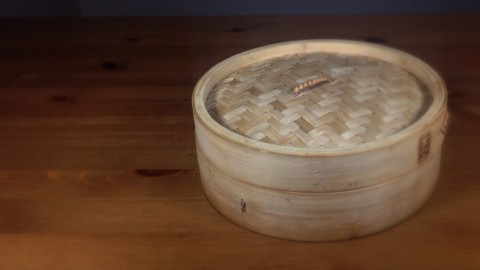
Some of the best things about having a wok come not from the cookware itself, but from the tools that go with it.
The big spatula is awesome for grilling big hunks of meat, where you want to keep a safe distance from the heat and also have something that can take a lot of weight.
The ladle is better than most of the Western ladles you’ll usually find as well.
And the steamer basket, as I mentioned above, is a godsend.
Not only is it great for steaming, but it is the ideal vessel for the initial slow-cooking step you do when making steaks or pork chops.
You see, the metal that most people put their meat on when cooking is an excellent conductor of heat, which means that the underside is going to get overcooked relative to the upper side.
But wood, on the other hand, is a poor conductor. So when you use the bamboo steamer to hold your meat, you are ensuring an even doneness throughout the meat, with no parts overdone.
(Safety alert: yes, I am telling you to put your bamboo steamer in the oven. But as long as you keep the temperature to our desired level of 225°F (105°C), you won’t be at risk of starting a campfire in your house.)
Wok Buyer’s Guide
Have I persuaded you to buy a wok yet?
Awesome. The good news is that a good wok shouldn’t set you back much. Here’s a few things you want to look for:
- Flat bottom–Some woks on the market are still made with a completely round bottom. Make sure you don’t get one of these, or it won’t be able to stand up on your stovetop.
- Carbon steel–Woks are made from all sorts of different materials, but carbon steel is best. It’s strong, lightweight, and heats up quickly.
- Get a lid–While you don’t need a lid for stir-frying, it will come in handy when you want to boil greens and your other pots are full.
This is the wok that I use, and personally recommend. The bad reviews on Amazon all seem to be coming from people who didn’t season properly, but I will show you how to do this.
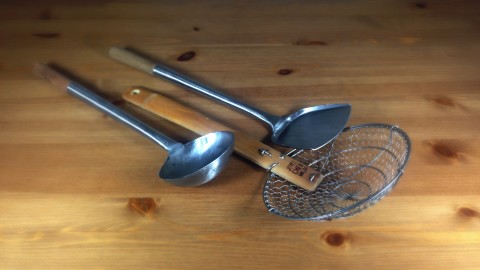
Additionally, there’s a few accessories you’ll want to get:
- A bamboo steamer is extremely versatile, as I mentioned above.
- A spider skimmer is amazing. Even if you don’t have a wok, you’ll want one of these. Necessary for getting food out of liquids, its the most perfectest slotted spoon ever.
- A wok spatula and ladle are essential for stir-frying and braising, as well as many other tasks.
- Some handkerchiefs for the steamer basket, if you don’t have any. They’re more economical and versatile than any steamer liners you might find.
How to Take Care of Your Wok
A new carbon steel wok is going to need to be seasoned first thing. Do not skip this step for any reason! You will potentially ruin your wok forever. (I’m stealing this from Cody Prime’s Amazon review, since it worked so well for me and others.)
- Assemble the wok handles, if necessary.
- Fill wok most of the way up with water and bring to a boil. Boil five minutes and carefully pour out water.
- Scrub all over (inside and out) with soapy water and steel wool or some other abrasive material. Really go at it here. This removes any lacquer, which can’t be present for the actual seasoning.
- Give the pan a rinse with clean water and put on stovetop over medium heat.
- Once any water has evaporated, the bottom will slowly turn a dark color.
- Move the pan all over the burner, developing the dark color over the entire pan. You’ll have to hold it at some weird angles, but you want that deep brown color over the entire surface.
- Once the wok is dark all over, pour in some peanut oil (recommended, but you can also use canola or vegetable oil if that’s what you have on hand) and rub all over the inside surface with a paper towel.
- Put the wok back on the medium burner and heat for 5–10 minutes. Turn on your oven’s exhaust fan if you have one!
Your wok is now perfectly seasoned! To maintain it, just remember these few things:
- Clean with water only (no soap) and a soft sponge or washcloth (no heavy-duty scrubbers).
- After cleaning, put the wok on a burner to evaporate any remaining water, then rub in a little peanut oil with a paper towel. This will help prevent rusting.
Lastly, those bamboo steamers, as cool as they look, can take a little patience to clean. Just remember these rules:
- Line the basket with plain handkerchiefs before putting food on. It’s easier to wash these than the steamer itself.
- Clean the steamer all over with plain water (no soap!).
- Dry the basket for a few minutes in a 225°F (105°C) oven to prevent mold.
The Gimmick That Isn’t
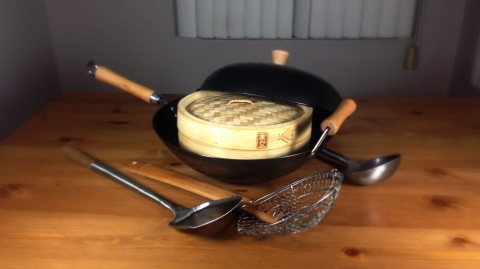
It’s too bad that most Westerners think of woks as a niche item, something to be given as gifts and only used once in a blue moon.
A wok is the main piece of cookware for literally billions of people, and has been in use for thousands of years.
Learning how to cook Eastern- and Southeast Asian food is certainly a huge selling point of owning a wok, but it needn’t stop there.
A wok (and its accompanying utensils) can be of great use in preparing many “Western” meals as well, and can stand in for both your Dutch oven and skillet if they are in use.
 I'm a science geek, food lover, and wannabe surfer.
I'm a science geek, food lover, and wannabe surfer.
Comments on this entry are closed.